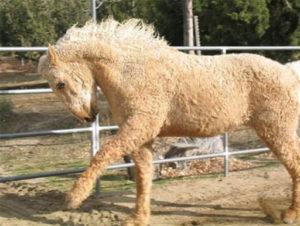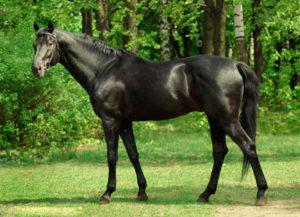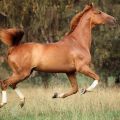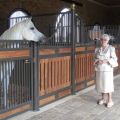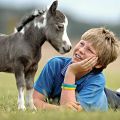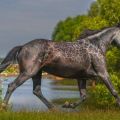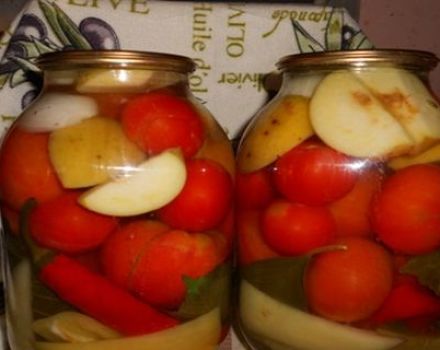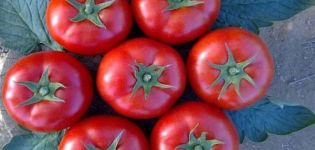Description and characteristics of the Vyatka horse breed and features of the content
History knows many cases when animals come to the aid of a person. People have long used the extraordinary abilities of dolphins, dogs or elephants. Horses bring invaluable benefits to their owners. For many years they have served people with faith and truth. More recently, it was impossible to exist without frisky horses. The Vyatka hardworking horse deserves special gratitude and respect.
The history of the origin of the Vyatka breed
The history of the horse is dramatic and amazing. Vyatka appeared as a result of crossing forest wild horses with domesticated horses. The unique breed was finally formed under the influence of harsh natural conditions. The culture of the indigenous population of Udmurtia had a great influence on the development of the valuable qualities of Vyatka. The first official information about the horses appeared in 1803. With the advent of playful, unpretentious horses, postal troikas came to the service of people. Strong, hardy horses ran hundreds of kilometers, doing their job day after day. In the 19th century, the widespread use of vyatka could be observed.
In the second half of the 19th century, the fashion for Western heavy draft horses came to Russia. Vyatka horses were thoughtlessly crossed with imported horses. This led to a sharp reduction in the Vyatka livestock. The breed was on the verge of extinction, and only at the end of the 30s of the 20th century, scientists began to restore the almost lost Vyatka breed. The work was carried out sluggishly, so the specialists did not achieve much success.
In the mid-80s of the 20th century, pedigree Vyatka horses were brought to Udmurtia. From that moment on, things went smoothly. Today, several breeding farms are successfully breeding amazing animals.
Horse description
The adorable horse does not have a catchy appearance. Unlike trotters, she does not boast graceful legs or a long neck. The attractiveness of Vyatka is akin to wildflowers - you will make out and you will never forget.
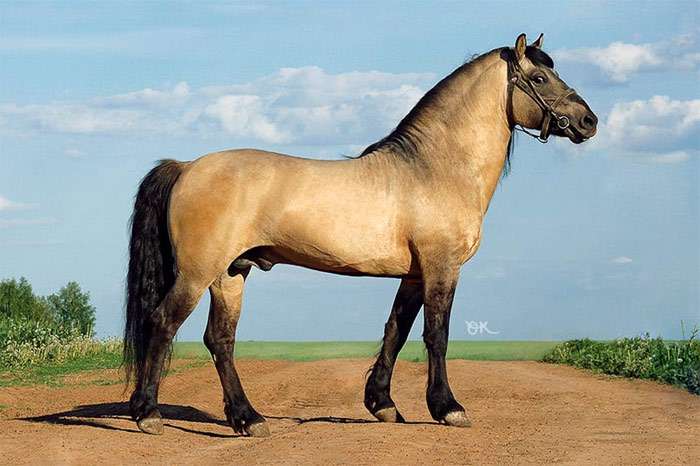
Exterior
By the standards of horse breeders, the Vyatka horse is not large in size. It grows and develops slowly, to mature age it barely reaches 150 cm at the withers. The animal has a well-balanced, rounded shape, which gives the small horse a neat look. Due to its modest growth, Vyatka is often mistaken for a pony.
Back in the 19th century, V.I.Dal described the Vyatka as a small, round, playful horse with lively eyes. Compared to representatives of race breeds, the Vyatka's neck is short, the head is small. A broad chest and a muscular croup speak of remarkable performance and endurance.In the North, horses always got roughage. The animal could only count on straw or hay. Vyatka had to digest meager, rough food. Spartan conditions were reflected in the appearance of the horse.
Vyatka's legs are short, but they stand out with developed hocks. Powerful, dry limbs make the horse feel confident over long distances. A straight, flat back seems to be created for the convenience of the rider. Thick, dense skin serves as a reliable protection for the horse from the bites of annoying insects. Thick wool helps the Vyatka to calmly endure the cold. Voluminous mane, bangs and a lush tail serve as a special decoration for the horse. Like a real fashionista, Vyatka's bangs picturesquely covers a flat forehead, and then obediently fits to the sides.
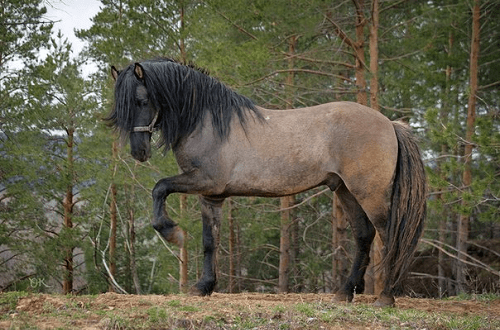
Savrasaya color is the original color of the Vyatka horse. In the homeland of Vyatka, you can find horses of all shades of savras suit, from pale yellow to deep brown. Less common are bay, red or mouse-colored horses. The visiting card of Vyatka can be called a dark stripe running along the horse's spine. This echo of the past, testifying to the wild origin of the animal, is called the "belt". A distinctive feature is the transverse stripes that adorn the horse's legs.
A dark haze is also inherent in the Vyatka breed - a coating that adorns the head, neck and shoulders of the animal. The main highlight of Vyatka is a curious and benevolent look from under the voluminous bangs. Only representatives of the Vyatka breed can look the owner so sincerely and tenderly.
Productive qualities
Taking into account the working qualities and the docile nature of the Vyatka, the horse is used only as a labor force and companion.
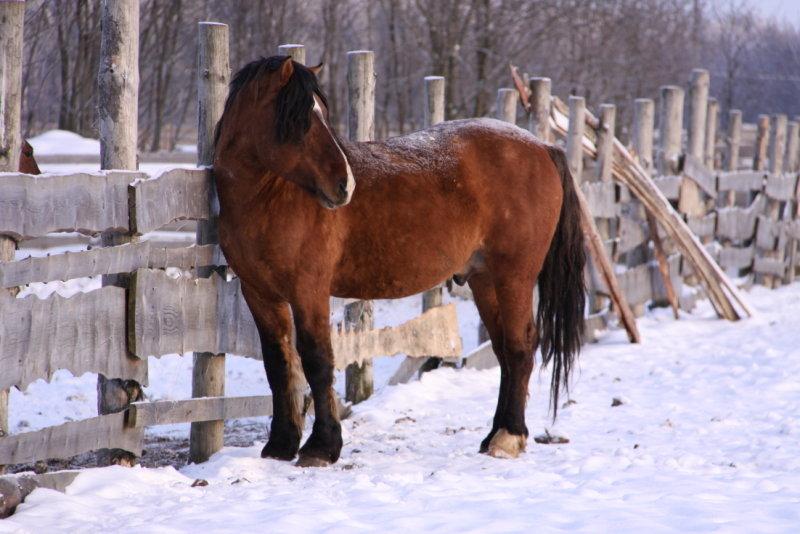
Temperament of the breed
The calm, complaisant disposition of the animal is a distinctive feature of the Vyatka breed. Savvy horses quickly assimilate information and obediently perform their duties. They are not intimidated by the sharp beeps of the car or the barking of dogs. In a frosty winter or in the pouring rain, horses do their job measuredly and calmly.
Vyatka get along well with horses of other breeds. They get along peacefully with numerous pets. Vyatka trusts a person. There are many stories to tell about the wonders of mutual understanding between people and horses of the Vyatka breed. Thanks to this character trait, even a teenager can take care of a pet.
Advantages and disadvantages
As in any business, the content of Vyatka has its pros and cons. Advantages:
- The horse is hardy and unpretentious.
- The animal is mentally stable, stable. Reacts calmly to external stimuli.
- The horse has strong immunity, so it rarely gets sick.
- Vyatka has a docile nature. Easy to learn.
- Horse maintenance is cost effective.

Disadvantages:
- The horse's hind legs are x-shaped. This feature slightly interferes with the freedom of movement of the animal.
- In some cases, you can find an insufficient density of attendants on the hind legs of the pet.
Features of the content
The horse of the Vyatka breed is unpretentious and tolerates any conditions of detention. However, in order for the pet to feel good and continue to be in great shape, you need to follow the rules. Despite the fact that the horse easily tolerates cold, the air temperature in the stable should not drop below 5 degrees Celsius. In the summer, the room needs to be ventilated. The floor is made of solid, undamaged planks. Otherwise, the pet runs the risk of serious injury. Sawdust is poured on top of the boardwalk. A layer of soft litter is made at least 6 cm. The cover is changed daily, animals do not feel well in a dirty, damp room.
Wet cleaning of the stall is carried out every 7 days. Before sanitizing the stall, the pet is taken for a walk.They let him in back only after the plank floor is dry.
The stable should be located in a spacious, well-lit area. The horse is provided with constant access to a portion of fresh hay. A drinker is installed in the stall. Every day the pet drinks at least 40 liters of water. Some craftsmen connect the drinker to the water supply system. Thus, the water in the drinker will always be fresh.

The horse's thick mane and tail are brushed daily using a special brush. Before the procedure, long strands are carefully fingered with your fingers. The echoes of the wild past affect the animal. The mane and tail of the Vyatka grow quickly, so the pet needs a regular haircut. A superficial examination of the animal's teeth is carried out 2-3 times a week.
The unpretentious Vyatoks are kept in a herd position until the Christmas holidays. Peace-loving animals calmly walk in freedom, picking the remnants of grass from under the snow. Horses do not refuse prey in the form of small twigs and bark.
After the break, the pets are released again. Horses are sent to free grazing with the onset of the April heat.
Horse diet
Unique horses can easily be content with hay and grass. The animal is genetically adapted to a poor diet. Loving owners delight the pet with a treat in the form of an apple, carrot or a serving of oats.
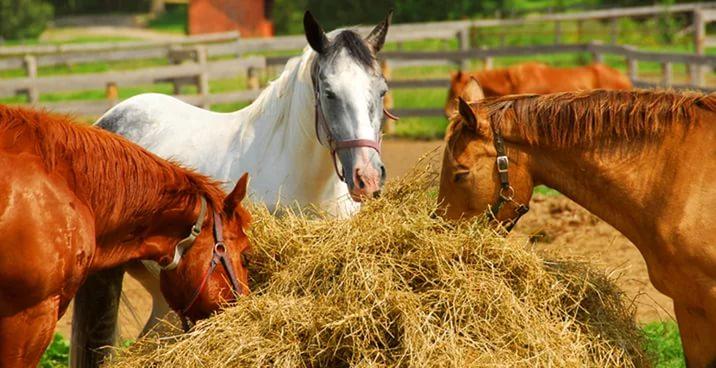
Breeding nuances
Vyatka horses are fertile and compete with representatives of other breeds. For many years, experts have been trying to improve the quality of Vyatka, increasing the growth of the animal, making it stronger and more resilient. Experiments on crossing Vyatka with individuals of other breeds ended in failure. Under the influence of trotting breeds, animals with an unstable nervous system turned out. Hot, easily excitable horses do not adapt well in difficult conditions. Reduced reproductive qualities.
When crossing with heavy trucks, the opposite problems arose. The offspring retained the adaptive qualities, but the character of the horses changed not for the better. The horses turned out to be phlegmatic and lazy. In addition, the appearance of the horses has lost its former attractiveness. When crossing the unpretentious Vyatka with other breeds, it should be borne in mind that a young horse will require more food, and in a northern climate there is little grass on pastures.
Frequent illnesses
Horses are resistant to colds. With a lack of movement, they may suffer from colic. Massive animals are prone to gaining excess weight, so food is kept under control. With poor hygiene in the stable, the horse can become infected with fungal or bacterial infections.

Scope of application
Once upon a time, Vyatka horses were used for riding troika, agricultural work and delivering mail. Today, smart animals are used in logging and field work in small farms. The Savrasks are entrusted with the transportation of goods over short distances. Horses are often used on equestrian tourist routes. The comprehension, natural delicacy and endurance of the horses help tourists to enjoy the journey to the fullest.
You cannot do without the Vyatka horse in the difficult case of rehabilitation of disabled children. Hippotherapy is a reliable means of relieving the suffering of young patients. Sometimes the little horse becomes the child's only friend.
The horses are used in children's equestrian sports. The small size of the Vyatka is convenient for riders in the age category of 10-13 years. For adolescents, the racehorse is too big, its height reaches 160 cm. The Vyatka horse seems to be created for working with children. In addition, the docile horse is easy to handle. Often, Vyatka is given as a companion. The animal readily responds to affection and care, it is easy to train.The horse has long lived in peasant yards, therefore it is trusting and attached to its owners.
